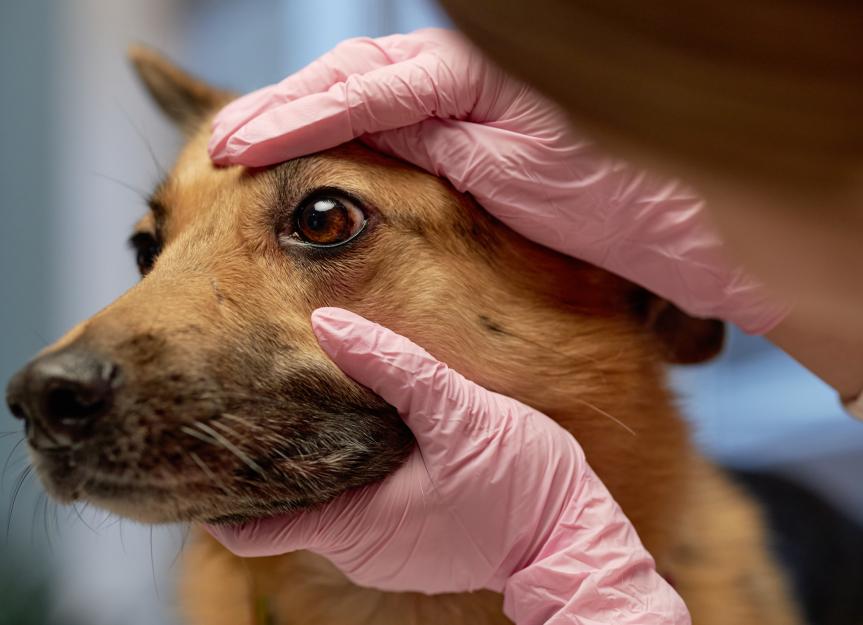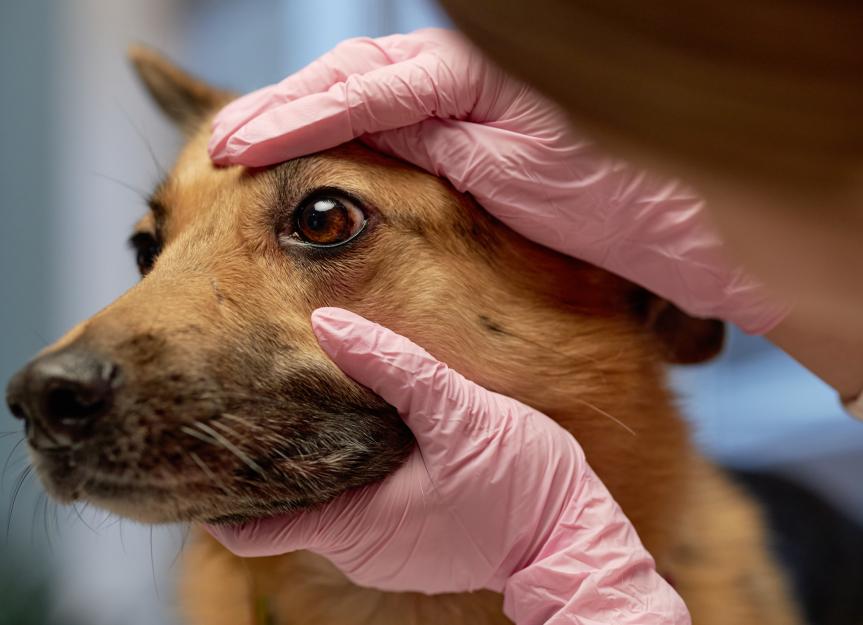
Painful, red eyes and eye discharge in your dog are understandably concerning to see.
Unfortunately, these may be signs of an eye condition called conjunctivitis, which develops because of inflammation or infection. There are a variety of causes, ranging from mild to severe.
Conjunctivitis in dogs is common, but it generally requires treatment by a veterinarian for resolution.
If you notice your dog’s eye appears red or she’s squinting frequently, contact your veterinarian for guidance.
Key Takeaways
- Conjunctivitis in dogs is common and can be caused by infections, allergens, injury, or underlying health issues.
- Symptoms include red eyes, discharge, squinting, and swelling, and treatment depends on the underlying cause.
- Most cases resolve within 7–10 days with veterinary care, but chronic conditions may lead to recurring flare-ups that require ongoing management.
What Is Conjunctivitis in Dogs?
Conjunctivitis refers to inflammation within the pink part of the eye, which is called the conjunctiva.
The conjunctiva covers the white part of the eyeball and the inside of the eyelids. The conjunctiva protects the dog’s eye, produces some of the dog’s tears for lubrication, and provides oxygen and nutrients to the eye.
The inflammation occurs for a variety of reasons, such as an infection or exposure to an allergen, which causes inflammatory cells within the eye to react. As a result, dogs with conjunctivitis develop concerning symptoms, such as unusual eye discharge, squinting, and eye redness.
Conjunctivitis is not generally a medical emergency in itself; however, it can become one if appropriate treatment is not given.
If left untreated, this condition can severely worsen and affect a dog’s vision.
If your dog is experiencing discomfort and pain, if they are having trouble seeing, or if the eye symptoms are persistent or worsen, contact a veterinarian immediately.
Causes of Conjunctivitis in Dogs
Conjunctivitis in dogs has a variety of causes, which can include:
-
Bacterial infection: Normal eye bacteria, such as Staphylococcus, can cause infection when a dog’s immune system is weak, leading to symptoms of conjunctivitis.
-
Allergen: Dogs with seasonal allergies to pollen or dust, for example, can experience eye inflammation.
-
Chemical or toxin exposure: Exposure to chemicals in the environment, such as from smoke, can irritate the eyeball and surrounding structures.
-
Eyelid abnormalities: Dogs with irregularities of their eyelids, such as improper turning of the eyelid or abnormal eyelashes, have an increased risk for conjunctivitis.
-
Tumors: Although rare, tumors that develop on the eyelid or the conjunctiva can cause significant inflammation within the eye.
-
Other eye conditions: Glaucoma and uveitis cause abnormal eye pressure, which can lead to inflammation within the eye.
Both males and females are equally likely to develop conjunctivitis. While this condition can affect dogs of any age, it is more common in puppies, young adults, and seniors, likely due to weaker immune systems.
Certain breeds, such as the Cavalier King Charles Spaniel, Pugs, German Shepherds, and Border Collies, are at an increased risk of conjunctivitis due to genetics.
How Veterinarians Diagnose Conjunctivitis in Dogs
A veterinarian will start with a complete physical exam by checking your dog over from nose to tail.
The eyes will be carefully examined visually and by using an ophthalmoscope, which is a special tool used to identify abnormalities within the eye and surrounding structures. Pet parents can describe any eye discharge they’ve noticed and when symptoms first occurred, giving the veterinarian a complete history.
If the veterinarian sees symptoms of conjunctivitis on an exam, she will do additional tests to identify the underlying cause, which don’t require any preparation at home by the pet parent. These may include:
-
Schirmer tear test: A small strip of paper is gently placed inside the dog’s eyelid to measure tear production. If the result is abnormally low, lack of tear production may be a contributing factor to the conjunctivitis.
-
Conjunctival swab: For severe cases or those not responding to initial treatment, a swab can be used to collect a sample from the conjunctiva so that it can be processed in a laboratory to identify the bacteria or virus causing the conjunctivitis.
Treatment of Conjunctivitis in Dogs
Treatment for conjunctivitis in dogs depends on the underlying cause.
Your veterinarian will determine the most appropriate treatment plan, but options may include:
-
Topical ointment. Ointments containing antibiotics and anti-inflammatories, such as Neo-Poly-Dex Ophthalmic Ointment, can improve conjunctivitis in some cases, especially when the underlying cause is a bacterial infection. Terramycin ointment is beneficial if a dog can’t use topical steroids, such as if she has a corneal ulcer.
-
Oral antibiotics. In severe cases or for dogs who do not allow topical administration, an oral antibiotic such as Clavamox can be prescribed.
-
Artificial tears. In some dogs, including those with viral infections, artificial tears can soothe and lubricate the eyes and improve symptoms.
-
Antihistamines. Dogs with allergies can benefit from antihistamines, including hydroxyzine, to reduce their eye symptoms.
-
Oral steroids. To reduce inflammation or treat an underlying immune-mediated disease, prednisone may be prescribed.
-
Other topical medications. Tacrolimus or cyclosporine may be prescribed if underlying immune-mediated conditions affecting the eye are diagnosed. Dorzolamide or atropine sulfate may be given to treat underlying glaucoma or uveitis that can contribute to conjunctivitis.
Some dogs may benefit from flushing the eye with saline at a veterinarian’s office to remove allergens or foreign objects.
Surgery may be required to correct eyelid abnormalities or remove tumors that contribute to symptoms of conjunctivitis.
A veterinarian will advise you on the most suitable treatment option based on your pet’s unique condition.
Recovery and Management of Conjunctivitis in Dogs
Generally, conjunctivitis in dogs is curable with appropriate treatment.
Most episodes of conjunctivitis clear within seven to 10 days, but some cases can take a few weeks to resolve.
In dogs with chronic underlying health conditions, flare-ups of conjunctivitis that require treatment can occur throughout the dog’s life.
Dogs may need to wear a cone while recovering from conjunctivitis, to prevent itching and pawing at their eyes.
Always follow your veterinarian’s instructions closely when treating your dog at home.
Prevention of Conjunctivitis in Dogs
Some cases of conjunctivitis in dogs may not be entirely preventable, such as those developing because of underlying immune-mediation conditions.
However, to reduce the risk for conjunctivitis in general, avoid exposing your dog to environmental allergens or chemicals.
Maintain regular wellness care, including vaccinations, to protect your dog against viral infections that can cause conjunctivitis.
Always follow your veterinarian’s instructions for managing any other health conditions your dog may have, because this can reduce their risk of secondarily developing conjunctivitis.
Conjunctivitis in Dogs FAQs
How do I treat my dog’s conjunctivitis?
Treating your dog’s conjunctivitis depends on the underlying cause. Your veterinarian can advise you on the best course of treatment after completing an exam on your dog.
Should I take my dog to the vet for conjunctivitis?
Yes, you should take your dog to the vet if you notice any concerning eye symptoms, such as redness, discharge, or swelling.
How long does it take a dog to get over conjunctivitis?
Dogs generally recover from conjunctivitis in seven to 10 days. However, some cases can take a few weeks to resolve. With chronic underlying health conditions, dogs may experience flare-ups throughout their lives that require management.
Can conjunctivitis be left untreated in dogs?
If you suspect your dog may have conjunctivitis, it’s important to see a veterinarian. Untreated conjunctivitis can become severe and lead to vision issues.
Will dog conjunctivitis dissipate if I use home remedies?
Conjunctivitis may go away on its own in some mild cases, such as if the dog were briefly exposed to an allergen. However, it is best to contact a veterinarian for guidance rather than using home remedies to treat any eye problems in your dog.
Will conjunctivitis go away by itself?
In some mild cases of conjunctivitis, symptoms may resolve on their own. However, it is important to contact a veterinarian for guidance to reduce the risk of complications if eye symptoms are left untreated.



